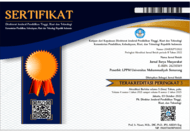Usaha Budidaya Jamur Tiram Putih (Pleurotus ostreatus) Untuk Mendukung Jiwa Kewirausahaan di Sekolah Menengah Kejuruan
(1) Universitas Cenderawasih
(2) Universitas Cenderawasih
(3) Universitas Cenderawasih
(4) SMK YPKP Sentani, Jayapura
(5) Universitas Cenderawasih
(6) Mahasiswa Universitas Cenderawasih
(7) Mahasiswa Universitas Cenderawasih
(*) Corresponding Author
Abstract
White oyster mushroom (Pleurotus ostreatus) is one type of mushroom as a source of vegetable food that is widely favored by the public. The quality of mushrooms that contain high protein, healthy food sources, and suitable for all groups. In Indonesia, the cultivation business has started to develop and not only among entrepreneurs, but also the general public. Efforts to understand cultivation need to be carried out from an early age, including in schools, so that it can become the basis for developing students' interests, especially related to entrepreneurship program activities. The purpose of this activity is to provide understanding, practice, and business of white oyster mushrooms at SMK YPKP Sentani. The methods used were FGDs, cultivation practices and small-scale cultivation businesses at the school level. The results of the activity showed that the students were enthusiastic in participating in the activity. After the activity all participants have recognized and understood the shape and morphological structure of mushrooms. This activity increased the understanding of white oyster mushroom cultivation by 175.3%, from 34.05% to 93.74%, and understanding of marketing potential reached 183.8% from 29.9% to 85.7%. Moreover, the results of their cultivation through mentoring can be successfully carried out independently at the school level. Businesses that are carried out with simple technology, and produce quality products are very attractive to them in entrepreneurship.
Keywords: white oyster mushroom; agro-industry; entrepreneurship; vocational school
Keywords
References
Ambit, J.P.R., A.M. Fernandez, J.P.L. Matuginas, H.D. Rupecio, Z.L. Zacarias, S.K. Basu, P. Zandi. 2023. The prospect and challenges of white oyster mushroom marketing (Pleurotus ostreatus). International Journal on Agricultural Sciences. 14(1): 18–25.
Bell V, Silva CRPG, Guina J and Fernandes TH. 2022. Mushrooms as future generation healthy foods. Front. Nutr. 9:1050099. doi: 10.3389/fnut.2022.1050099.
Colunga, A., Mario Alberto Cruz-Hernández, Carolina Losoya, Ruth Belmares. 2020. Edible Mushrooms as a Novel Protein Source for Functional Foods. Food & Function. 11(9): DOI: 10.1039/D0FO01746A.
Elfandari, H., Yusanto, dan Septiana. 2021. Pertumbuhan dan produktivitas jamur tiram putih (Pleurotus ostreatus) pada komposisi media tanam sengon dan jerami. Jurnal Agrotektropika. 9(2): 301–305.
Hidayah, H.A., R.R. Al-Hakim. 2022. Etnobotani: Belajar dari pemanfaatan tumbuhan liar. Sintesa: Jurnal Ilmu Pendidikan. 17(1): 8–14.
Iskandar, J. 2016. Etnobiologi dan Keragaman Budaya di Indonesia. UMBARA: Indonesian Journal of Anthropology. 1(1): 27–42.
Kadir, A., Suharno, A. Ali, dan Y.N.I. Reawaruw. 2022. Dari masyarakat adat Marind Anim Papua, Sagu local untuk ketahanan pangan nasional. Penerbit IPB Press. Bogor.
Khastini, R.O., N. Maryani, and I.D. Lestari. 2023. Wild Edible Mushroom, a Potential and Valuable Source for Food Security In: N. Huda et al. (Eds.): ICSAFE 2022, ABSR 25: 160–168. https://doi.org/10.2991/978-94-6463-090-918.
Maridi. 2015. Mengangkat budaya dan kearifan lokal dalam sistem konservasi tanah dan air. Seminar Nasional XII Pendidikan Biologi FKIP UNS 2015. pp: 20-39.
Puspita, M. 2017. Kearifan local dalam pengelolaan sumber daya pesisir dan laut: Hukum adat Laot dan Lembaga Panglima Laot di Nanggore Aceh Darussalam. Sabda: Jurnal Kajian Kebudayaan. 3(2). https://doi.org/10.14710/sabda.3.2.%p.
Sufaati, S., V. Purnamasari, V. Agustini, dan Suharno. 2017. Tambir: Jamur alam Papua yang berpotensi sebagai jamur konsumsi. Jurnal Biologi Papua. 9(1):20–24.
Sufaati, S., Suharno, R.H.R. Tanjung, Y. Sopian, T.A. Mushid, Juwita, Parjan, E.M. Busup, dan N. Fakdawer. 2023. Peningkatan kualitas siswa dalam pembelajaran proyek penguatan profil pelajar pancasila (P5) melalui usaha budidaya jamur tiram putih (Pleurotus ostreatus). Bakti Hayati, Jurnal Pengabdian Indonesia. 2(2): 38–44.
Sujarta, P., A. Renyoet, dan L. Dimara. 2020. Tradisi tiaitiki: Konsep, penerapan, dan manfaat. Penerbit Samudera Biru. Yogyakarta.
Wang, M., and R. Zhao. 2023.A review on nutritional advantages of edible mushrooms and its industrialization development situation in protein meat analogues. Journal of Future Foods. 3-1 (2023) 1–7.
Mardianti, N.A., Saadah, R.A. Nadja, A.N. Tenriawaru, N.M.V. Sulianderi. 2022. Strategi pemasaran efektif untuk meningkatkan produksi dan pendapatan usaha jamur tiram (Studi Kasus PT Timur Mushroom Farm Desa Kuajang Kecamatan Binuang Kabupaten Polewali Mandar Sulawesi Barat). JIA (Jurnal Ilmiah Agribisnis): Jurnal Agribisnis dan Ilmu Sosial Ekonomi Pertanian. 9(1): 27-37. Doi: http://doi.org/10.37149/JIA.v9i1.965.
Yulianto, A.R., M.F. Rizaldi, dan A. Faqih. 2023. Business development strategy of white oyster mushroom (Pleurotus ostreatus). Devolution: Journal of Research and Community Service. 4(9): 1794-1803.
Article Metrics
Abstract view : 0 timesRefbacks
- There are currently no refbacks.
Copyright (c) 2024 Jurnal Surya Masyarakat

Jurnal Surya Masyarakat (JSM) is licensed under Creative Commons Attribution-NonCommercial-NoDerivatives 4.0
------------------------------------------------------------------------------------------------------------------------
Jurnal Surya Masyarakat (JSM)
p-ISSN: 2623-0364; e-ISSN: 2623-0569
Published by: Lembaga Penelitian dan Pengabdian Masyarakat (LPPM) Universitas Muhammadiyah Semarang



.jpg)







.jpg)